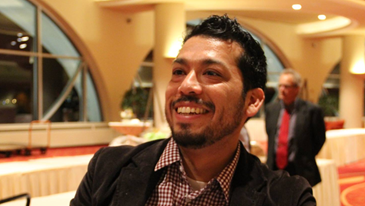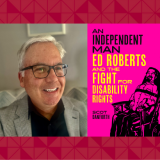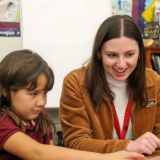Q & A with New Faculty Member Jorge F. Rodriguez
October 16, 2017

What is your educational background?
I am very proud to be a first generation college student within the United States. One of the major reasons for this feeling is recognizing that my educational trajectory was only possible due to the determination and heart work of my mother. My parents immigrated to this country from Mexico in 1978 and were able to gain U.S. residency through the Immigration Reform and Control Act of 1986. I was only eight years old when my parents officially received their documents and residency cards. I remember the emotion, relief, and happiness felt within our household as the previous ten years of my family’s experience was one based in fear and hardship. My mother comes from a small town in Coahuila Mexico, the daughter of an orphan indigenous woman of Toboso heritage. Very little is known of my grandmother’s past, however my own mother’s determination originates from her mother’s spirit. It is important for me, when speaking of my educational background, to remember and honor those individuals, especially the matriarchs, and communities that sacrificed and struggled for my benefit.

Mother (Flavia Rodriguez on the left and her friend on the right)
I grew up on the southside of Santa Ana, just down the street, figuratively speaking, from Chapman University. I went to Washington Elementary School in the Memorial Park Neighborhood. In the third grade, I was then moved to the Garden Grove Unified School District (GGUSD), after school officials from the Santa Ana Unified School District (SAUSD) strongly recommended that I be placed on medication for a mis-diagnosis of Attention-Deficit Hyperactivity Disorder (ADHD). In my mother’s eyes, I was only an active kid, similar to most of my cousins and brothers. Scared and resistant to the school’s recommendation, she decided to transfer me out of SAUSD. In the GGUSD, I went to Fitz Middle School, and Los Amigos High School, and although these schools fall within the GGUSD, they are still contextually within the City of Santa Ana.

After graduating from Los Amigos High School I went to Santa Ana College, and eventually transferred into the University of California Irvine. Navigating the college systems as a first generation student was difficult and alienating, however I enjoyed learning and experiencing the opportunities higher education provided for me. As a transfer student I remember taking my first ethnic studies courses in Black Studies and Chicana/o Studies at UC Irvine. One of the first books I read was “The Mis Education of the Negro” by Carter G. Woodson and I remember feeling passionately connected to the text, as what was being said within the book applied to me and my community. I also learned about the Chicana/o Movement, and for the first time in all my life I met faculty and read about people like Corky Gonzalez, and women such as the Adelitas (Revolutionary Woman of Mexico). These important historical figures reflected my identity, culture, and history. My experiences within higher education allowed me to personalize and own my education.
UC Irvine awoke in me a desire to continue my education, and after graduating from the UC system and then working within the Santa Ana Non-Profit Sector for a year, I applied to the Masters Program of Counseling Psychology at the University of Wisconsin Madison (UW-Madison). Directly after completing my Masters program, I applied to the Ph.D. Curriculum and Instruction Program within the School of Education at UW –Madison. There I began to work with faculty and scholars whose research and community work were based in Culturally Relevant Pedagogy, popular education, critical education, and youth resistance. Scholars such as Michael Apple, Gloria Ladson Billings, Diana Hess, and Carl Grant gave me the theoretical tools to make sense of my communities’ experience. And while at UW-Madison I engaged in community work, specifically applying everything that I was learning with the immigrant youth of the city of Madison. I created programs, such as the Xicanx Institute for Education and Self Determination (XIES), worked closely with the Ho-Chunk and Menominee Indigenous Nations, and built curriculum and programing with the Chicanx, and immigrant communities of the city.
At UW –Madison I learned about Critical Education, Critical Race Theory, and the political/ cultural realities and tensions of the world of education. I learned how to engage and teach from a position of praxis (theory and practice) and as a critical scholar activist I learned to be active in scholarship, advocating with and serving with marginalized communities. Most importantly, at UW –Madison, I learned how to look inward, reflecting upon my privileges and lived experiences. I realized the importance of unlearning my preconceived assumptions and ideas of society and I learned to understand identity from both a privileged and oppressed perspective. As my mentor Dr. Seema Kapani states, “We are all walking wounded and walking oblivious”, from that I learn that the process of critical consciousness, as Paulo Freire mentions, truly starts with the self.
What is your philosophy in educating?
As an educator I strive to create what Paulo Freire, critical educator, describes as a horizontal and critical learning environment. A horizontal and critical classroom is one where students are experts in their own experiences and realities, and where both the student and teacher enter into a learning relationship where they can mutually learn from each other’s’ contexts and contributions. In the classroom I embrace a model of teaching that 1) centers the student’s experience within critical reflection, 2) allows the student to engage, educate, and process their personal experiences in comparison to their social, political, and economic environments, 3) motivates students to engage in action, based on what they have learned and/or unlearned, and 4) creates space for self and social evaluation. The four areas of learning are reflective of indigenous-based principles of how to become a balanced and contributing individual within society.
These four principles described reflect what are known as the Four Tezcatlipoca’s, a set of Uto-Nahualt-based values still embraced by many of the indigenous communities of Central and South America, as well as indigenous communities of the United States. I first learned of this pedagogical approach in Tucson, Arizona as I conducted my research and dissertation on the politics of knowledge and the Ethnic Studies Ban HB2281. Through working with and observing the work of the Ethnic Studies teachers at Tucson Unified School District, I was able to engage and learn this pedagogical approach for my teaching and self growth. As a witness to the impact and transformation evident within the lives of many of the students who engaged in this pedagogy in Tucson, I saw it appropriate to adopt such a pedagogical approach and philosophy within my teaching and being. The blend of both a Freirian and indigenous-based approach to teaching and learning allow me to engage equitably, within a social justice lens in the classroom and beyond.
The purpose of my teaching philosophy is to demonstrate the importance of transforming the environments by which youth and community engage, creating living environments that promote human flourishing.
What is your area of research/expertise?
My research examines the influential role that culture and power play within school systems across the United States. My work explores the politics of knowledge, centering narratives, history and context often devalued and erased within the dominant ideology and identity of the country. I am preoccupied with understanding the role and constant shifting relationship between hegemony, ideology and culture and its influence within our schools. My research captures the narratives and stories often overlooked within mainstream systems of power, while informing practice and developing supportive resources for youth and communities of color. The focus and trajectory of my work document and amplify the politics of identity and representation as they relate to systems of power and education. Given the dominant narratives and political ideologies of our time my research strives to follow social movements, community interactions, and cultural expressions that directly counter the status quo.
My work addresses and points to an irrelevant curricula taught and enforced within the schools of the United States. Schools are failing to include culturally and historic realities of underserved communities. My research further explores the radical possibilities of what culturally relevant curricula looks like when operationalized within communities whose history, culture and context is traditionally not reflected within the classroom.
What do you hope to bring to the Attallah College?
I have many goals and aspirations working within the Attallah College of Educational Studies (ACES) at Chapman University. First and foremost I wish to establish a strong relationship with the students of our college. I look forward to meeting as many students as I can. Please search me out, I would love to have coffee, or tea, or just sit with you all to build community. I am sincerely impressed with our ACES student body. The critical and self-reflective quality of our students present within my current classes is truly admirable and exciting for me.
I am also excited to be back home and in proximity to the environment I grew up in. Santa Ana is a dynamic and diverse community and I hope to establish a stronger relationship between our College and the resources and initiatives currently being developed by youth, and community. As I prepare for next semester, specifically around IES 102: Social Constructions of Difference, IES 315: NGOs: Policy and Practice, and IES 316: Aesthetics in Education, I am excited to build curriculum that exposes our students to active community programming, movements, and expertise from local practitioners, educators, and organizations.
For those enrolled within the IES: 316 course, next semester, our class will be primary in hosting and learning directly from Filmmakers of Oaxaca, Mexico, documenting their indigenous struggles and disseminating their stories through film. Our class will also discuss popular education, interviewing and directly speaking with members of the Coalition of Immokalee Workers in Florida, a civil rights award winning organization, fighting for farmworker rights in the field. Likewise our class will be visiting local murals and muralist, performers, activist and educators that use art and education to transform community.
Furthermore I am excited to also build with my fellow faculty colleagues and the larger Chapman Community. I am honored to be amongst a powerful and talented group of scholars and educators within our college. The welcoming atmosphere you have given me, as a new faculty member has been beautiful. Thank you for creating that community for me. I look forward to getting more involved within the Chapman community and contributing in whichever way I am able to further the excellence of our University. I’m proud to now call myself a Panther!
Who/ what inspires you?
What truly inspires me is the resilience and determination of marginalized communities especially those of indigenous, black, and immigrant context. I am inspired by the narratives of human flourishing, despite of the social and structural inequalities at hand. I honor the countless stories passed down from generation to generation, and become motivated and emotional when their stories are documented in the form of poetry, murals, and songs. I do not wish to romanticize these stories, as they originate in suffering, and struggle, however, I am amazed at the resiliency and sincerity of the human spirit. The expression of hip-hop, punk, traditional music, blues, and bluegrass in their origin begin with an attempt to express, heal, and document human struggle. Youth also inspire me, I believe their courage, energy and sincerity for social justice keep our communities honest and accountable toward developing a better society. It is no surprise that at the root of the hip-hop movement, the punk DIY (do it yourself) scene, and beginning of the Civil Right Movements across the Americas, youth were significant and key within our history. One of my favorite albums called Distant Relatives by Damian Marley and Nas has a song called Patience (Sabali) where Damian Marley sarcastically says, “Pay no mind to the youth, cuz its not like the future depends on it…” the song continues with the hook saying “Sabali, Sabali, Sabali, yonkontê Sabali, Sabali, Sabali, kiye Nikêra môgô”. The whole phrase means “Patience, Patience, Patience, it’s what the world is about. Patience, Patience, Patience, let’s all join souls”. This phrase in the Bambara, Mali language describes the wisdom and strength of our youth movements today. I am inspired by their ability to look at our past in order to look toward our future.

